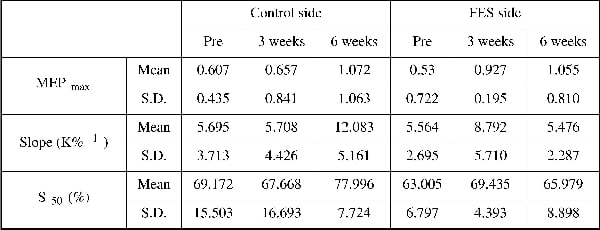Chronic electrical stimulation is frequently used in neurorehabilitation [1]. Transcranial magnetic stimulation (TMS) studies have shown that there is short duration (<2hr) changes in motor cortical excitability following brief bouts of electrical stimulation (ES) of nerves and muscles [2]. This study examined changes in cortical motor excitability in normal subjects following 6 weeks of daily ES. Five subjects (2 female, 1 left hand dominant, 25-55 years) underwent half hour daily sessions of ES to dominant side m. extensor carpi ulnaris (ECU) for 6 weeks. ES was delivered for 30 min in 10 sec trains of 20 Hz; 2-10 mA; ramping 5 sec rise and fall, delivered via surface electrodes and reinforced by concurrent volitional contraction. The non-dominant ECU received no exercise or treatment. TMS stimuli were applied using a biphasic Magstim unilaterally to the hot spot for ECU of the left and right motor cortex. Motor evoked potentials (MEPs) were recorded from surface electrodes over ECU. Stimulus–MEP response curves for each side were obtained from average MEPS (n=5) in response to a series of stimulus intensities (30 to 100% maximal stimulus output) at 5% increments obtained before, at 3 weeks, and at 6 weeks of electrical stimulation. The nonlinear curves were fitted with Boltzmann function [3] using PC software (Sigmaplot 2000). The mean and S.D. for the stimulus-response curves are shown in Table 1. No significant differences between the parameters of the stimulus-response curves (repeated measures ANOVA) were obtained for either side. This suggests that in normals, the well known effects of ES, is similar to several weeks of resistance training [3] in not inducing long lasting reorganization of motor cortex, despite producing short term changes in cortical excitability. However, further work is needed to investigate plasticity at a spinal and cortical level following chronic electrical stimulation.
University College London 2006 (2006) Proc Physiol Soc 3, PC51
Poster Communications: The effect of chronic electrical stimulation to forearm extensor muscles on cortical plasticity
John Cossar1, Amanda Austin1, Elizabeth Bond1, David W Maskill1, Alexander V Nowicky1, Neil E O'Connell1
1. Centre For Research In Rehabilitation, Brunel University, London, United Kingdom.
View other abstracts by:
Table 1. The mean (n=5) curve fitting parameters for the control and ES side MEP responses from ECU are shown
Where applicable, experiments conform with Society ethical requirements.

